Abstract
We present a brief overview of the existence/nonexistence of standing waves for the NonLinear Schrödinger and the NonLinear Dirac Equations (NLSE/NLDE) on metric graphs with localized nonlinearity. First, we focus on the NLSE (both in the subcritical and the critical case) and, then, on the NLDE highlighting similarities and differences with the NLSE. Finally, we show how the two equations are related in the nonrelativistic limit by the convergence of the bound states.
Keywords:
metric graphs; NLS; NLD; ground states; bound states; localized nonlinearity; nonrelativistic limit MSC:
35R02; 35Q55; 81Q35; 35Q40; 49J40; 49J35; 58E05; 46T05
1. Introduction
The aim of this paper is to present the state of the art on the study of the standing waves of the NonLinear Schrödinger and the NonLinear Dirac Equations (NLSE/NLDE) on metric graphs with localized nonlinearities (for a summarizing scheme see Section 5).
In the following paper, by metric graph we mean the locally compact metric space which one obtains endowing a multigraph with a parametrization that associates each bounded edge with a closed and bounded interval of the real line, and each unbounded edge with a (copy of the) half-line (an extensive description can be found in [1,2] and references therein). Consequently, functions on metric graphs must be seen as bunches of functions such that . Consistently, Lebesgue and Sobolev spaces are defined as
and are equipped with the natural norms. Moreover, throughout this article, -norms are denoted by and the -norm is denoted by for the sake of simplicity.
It is also worth recalling that in the present paper we limit ourselves to focus on the case of metric graphs satisfying the following hypothesis:
Hypothesis (H1).
is connected andnon-compact;
Hypothesis (H2).
has a finite number of edges;
Hypothesis (H3).
has a non-emptycompact core (which is the subgraph of consisting of all its bounded edges);
(see, e.g., Figure 1).
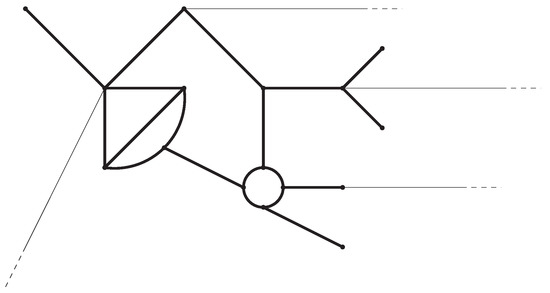
Figure 1.
A graph satisfying (H1)–(H3) and its compact core (bold edges).
The growing interest in the study of evolution equations on metric graphs and networks is due to the fact that they are regarded as effective models for the dynamics of systems constrained in branched spatial structures (see [3] and references therein).
In particular, in recent years a considerable attention has been devoted to the focusing NLSE, i.e.,
where is a suitable self-adjoint realization of the operator
and, precisely, on the existence of standing waves of (1). Those are functions of the form
with and , solving the stationary version of (1), namely,
The physical motivations for the study of the NLSE on metric graphs are extensively explained, e.g., in [3,4,5] and references therein. We limit ourselves to mention the application to the study of the qualitative behavior of Bose-Einstein condensates in ramified traps (that can be presently realized in laboratory as shown, e.g., by [6]) and to the study of nonlinear optics in Kerr media. In particular, in nonlinear optics one can mention, for instance, the discussion of arrays of planar self-focusing waveguides and of propagation in variously shaped fiber-optic devices (such as Y-junctions, H-junctions, and so on).
The first results in this direction (see, e.g., [7,8,9,10]) considered the so-called infinite N-star graph (see, e.g., Figure 2) in the case where is the Laplacian with -type vertex conditions, that is
where
for some ( meaning that the edge e is incident at the vertex , while stands for or according to whether is equal to 0 or at ).

Figure 2.
Infinite N-star graph ().
On the other hand, in the case , which is usually called Kirchhoff Laplacian (and which will be denoted simply by in place of in the sequel for the sake of simplicity), more general graphs have been studied (precisely, any graph satisfying (H1)–(H2)). We mention, in this regard [1,11,12], for a discussion of the existence of ground states (i.e., those standing waves that minimize the energy functional associated with (2)) and [13,14,15,16,17] concerning more general excited states, a.k.a. bound states. We also mention [18] where the same problems are studied in the presence of an external potential.
A modification of this model, introduced in [5,19], consists of assuming that the nonlinearity affects only the compact core of the graph (which then must be supposed non-empty as in (H3)) so that (2) reads
where is the characteristic function of . The existence of stationary solutions to (5) has been discussed in [20,21,22] in the -subcritical case, i.e., , and, more recently, in [23,24] in the -critical case, i.e., . A detailed description of these results will be presented in Section 2.
For the sake of completeness, we also remark that the NLSE on compact graphs (which, in particular, do not fulfill (H1)) has been studied, e.g., in [25,26,27,28]; while the case of one or higher-dimensional periodic graphs (which, in particular, do not fulfill (H2) as, for instance, in Figure 3) has been addressed, e.g., by [29,30,31,32].
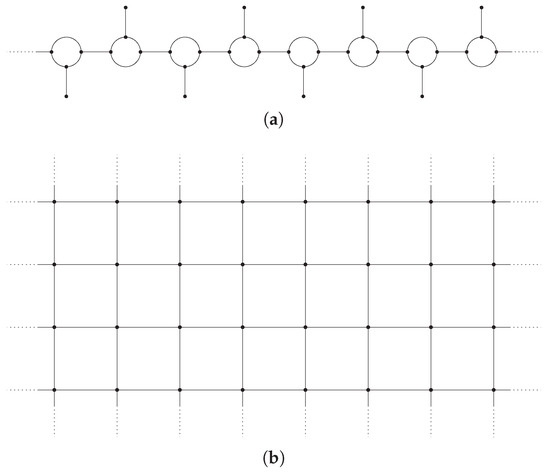
Figure 3.
Two examples of periodic graphs: (a) A one-dimensional periodic graph; (b) A two-dimensional grid.
Besides the NLS, other dispersive PDEs on metric graphs have been explored in recent years. We mention, for instance, the case of [33] which deals with the dynamics for the Airy equation (motivated by the study of the KdV equation) on star graphs.
On the other hand, other newly studied issues on metric graphs concerns different types of nonlinearities for the NLSE with interesting implications in some physical models (see, e.g., [34]): nonlinearities which are nonlocal and/or present a PT-symmetry (see, e.g., [35,36]). In particular, the question of the PT-symmetry in quantum graphs has been discussed in the last few years with a focus only on linear problems and, precisely, on the issue of detecting PT-symmetric vertex conditions for symmetric operators on graphs (see [37,38]). Nevertheless, nonlinear PT-symmetric equations on graph are completely unexplored and may represent an interesting topic for future research.
Recently, we started a new research project concerning the NLDE on metric graphs in [39]. The physical motivations for such a model mainly come from solid state physics and nonlinear optics. The existence of Dirac solitons in Bose-Einstein condensates and optical lattices and their concrete realization in discrete waveguide arrays have been investigated in [40,41]. In that case one may expect to recover the metric graph model in an appropriate scaling regime. We also mention that a rigorous mathematical study of the dynamics and the existence of Dirac solitons on lattices has been recently treated in [42,43,44,45,46].
The search for the stationary solutions of the NLDE in this context has been first proposed by [47] for the case of the infinite 3-star graph (see Figure 4). However, in [47] the authors considered the case of an extended nonlinearity, i.e.,
where is a suitable self-adjoint realization of the one-dimensional Dirac operator , i.e.,
and representing the mass of the generic particle of the system and a relativistic parameter (respectively), and and representing the Pauli matrices, i.e.,
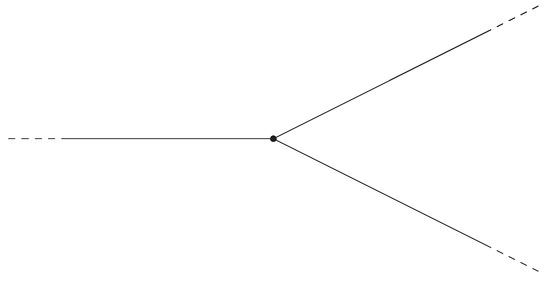
Figure 4.
Infinite 3-star graph.
Here the equation of the standing waves reads
In fact, in order to deal with more complex graph topologies, in [39] we restricted ourselves to the case of a Kirchhoff-type extension of the Dirac operator (for details see Section 3.1) and, most importantly, we considered the case of a localized nonlinearity, that is
In addition, in order to test the consistency of this model we also proved (see Section 4) the convergence (of the bound states) of (7) to (the bound states of) (5) in the nonrelativistic limit, namely as “”.
Please note that in (7) (as in the equation studied in [47]) the nonlinearity is a pure power, thus being manifestly non-covariant. This kind of nonlinearities typically arises in nonlinear optics. We also stress that from a theoretical point of view there is no conceptual contradiction as the NLDE should be intended only as an effective model.
Nevertheless, the equation obtained replacing the nonlinearity with a covariant one, i.e.,
(the nonlinearity now being defined in terms of a Lorentz-scalar) is of great interest. This equation, indeed, might be interpreted as the model for a truly relativistic particle (a Dirac fermion), whose dynamics is constrained to a one-dimensional structure. In this case, the model should be Lorentz-covariant (strictly speaking, in this case the equation should be rewritten in covariant form). We expect that this will require some technical adjustments to deal with the indefiniteness of the nonlinearity. This might be quite relevant in the study of the nonrelativistic limit, since in [39] we used the fact that a positive nonlinearity allows to get a priori estimates uniform in c.
Finally, we mention that the discussion of extended nonlinearities presents some technical problems that we were not able to overcome thus far. However, we plan to investigate this question in a forthcoming paper.
2. Nonlinear Schrödinger Equation
The study of the existence/nonexistence and multiplicity of bound states of (5) carried on in [20,21,22,23,24] is completely based on variational methods.
This is due to the simple observation that -solutions of (5), with denoting the Kirchhoff Laplacian, arise also as constrained critical points of the energy functional
on the manifold
for some fixed (but arbitrary) , where
Moreover, if u is a constrained critical point, also known as bound state, then computation shows that the Lagrange multiplier can be found as
Remark 1.
2.1. Ground States
The first step in the study of the bound states consists in looking for ground states, namely the constrained minimizers of on the manifold .
Ground states can be shown (see [1]) to be of the form
where is a fixed phase factor and v is real-valued. Hence, in the following, in minimization problems we will always limit ourselves to consider real-valued functions.
For more general bound states we cannot prove at the moment that such a property holds. Therefore, while in existence and multiplicity results we will limit to real-valued functions, nonexistence results concern also complex-valued functions.
2.1.1. The Subcritical Case:
We start reporting on the existence of constrained minimizers in the so-called -subcritical case, namely, when .
For and for every graph satisfying (H1)–(H2) it is possible to prove (see, e.g., [11], [Proposition 2.1] and [22], [Proposition 4.1] for real-valued functions and [21], [Proposition 2.6] for complex-valued functions) that the following Gagliardo-Nirenberg inequalities hold:
with and denoting the optimal constants of the respective inequalities. Then
so that
and, if , this immediately entails that the functional is bounded from below on the manifold .
Remark 2.
Please note that in fact, (10) and (11) hold for every under the sole assumption (H2), up to a redefinition of the optimal constants. However, we chose to mention the -version, which holds even if (H2) is not fulfilled. We remark that the best constants of these versions play a crucial role in the analysis of the ground states.
As a consequence, the following results can be established
Theorem 1
([22] [Theorems 3.3 and 3.4], [21] [Corollary 3.4]). Let satisfy (H1)–(H3) and let . Therefore:
- (1)
- if , then there exists a ground state for every ;
- (2)
- if , then:
- (i)
- wheneverwhere N is the number of half-lines of andthere exists a ground state of mass μ;
- (ii)
- wheneverthere does not exist any ground state of mass μ.
The proof of the previous theorem is clearly based on (13) and (14). Precisely, from (14) there results that the existence part can be obtained exhibiting a function with negative energy, usually called competitor. This can be achieved for every mass when , while when this is possible only under (15). Such competitors are constant on the compact core and exponentially decreasing on half-lines. In this way they minimize the kinetic energy on the compact core and have the exact qualitative behavior of the bound states on the half-lines (where the problem is linear). Clearly, such competitors cannot be minimizers since they do not fulfill (4) with .
On the other hand, (13) shows that to prove nonexistence, it is sufficient to prove that every function possesses a strictly positive energy level. This is, actually, the idea behind the first proof of the nonexistence result for ground states. However, there is also another strategy, which is similar to that of the proof of Theorem 5, which allows to prove item 2)(ii) in a straighter way and with the sharper threshold given by (16).
Finally, it is worth mentioning both that the negativity of the energy levels of the minimizers entails that the associated Lagrange multipliers (given by (9)) are negative, and that the results of Theorem 1 are invariant under the homotetic transformation
In other words, if one sets for instance , then a problem on a graph with a given mass constraint is completely equivalent to a problem with half the mass and a “doubled” graph, and vice versa.
2.1.2. The Critical Case:
The study of the so-called -critical case has been successfully managed only very recently. Here the main difficulty comes from the fact that the boundedness from below of the energy functional strongly depends on the mass constraint.
Indeed, in this case (12) reads
and hence the boundedness of functional clearly depends on the value of . In particular, it turns out that the discriminating value is related to the best constant of (10); that is, the critical mass of the problem is defined by
It is well known that when
that
and that are the sole values of the mass constraint at which the problem with the extended nonlinearity on (respectively) admits a ground state (see, e.g., [48]).
However, one can easily see that, while for the problem with extended nonlinearity (treated in [12]) is the proper parameter to be investigated, in the localized case one should better consider a reduced critical mass
where denotes the optimal constant of the following modified Gagliardo-Nirenberg inequality
namely
In fact, using this new parameter one obtains
which is clearly sharper than (17), as one can easily see that .
Existence of ground states has been first investigated in [23] in the simple case of the tadpole graph (see Figure 5). Very recently more refined results have been obtained without any assumption on the topology of the graph, thus providing a (almost) complete classification of the phenomenology.

Figure 5.
Tadpole graph.
To state such results, let
and recall the following definitions for a metric graph:
- a graph is said to admit a cycle-covering if and only if every edge of belongs to a cycle, namely either a loop (i.e., a closed path of consecutive bounded edges) or an unbounded path joining the endpoints of two distinct half-lines (which are then identified as a single vertex at infinity);
- a graph is said to possesses a terminal edge if and only if it contains an edge ending with a vertex of degree one.
Theorem 2
([24] [Theorem 1.1]). Let satisfy (H1)–(H3) . Then,
In addition,
- (i)
- if has at least a terminal edge (as, for instance, in Figure 6a), thenand there is no ground state of mass μ for any ;
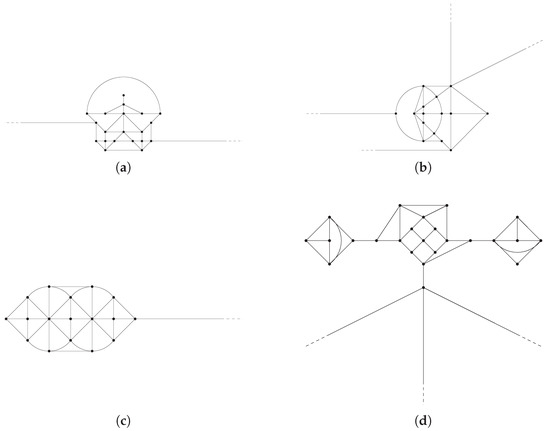 Figure 6. Examples of graphs from cases (i)-(iv) of Theorem 2: (a) A graph with one terminal edge; (b) A graph admitting a cycle-covering; (c) A graph with one half-line and without terminal edges; (d) A graph without terminal edges and cycle-coverings, and with two half-lines.
Figure 6. Examples of graphs from cases (i)-(iv) of Theorem 2: (a) A graph with one terminal edge; (b) A graph admitting a cycle-covering; (c) A graph with one half-line and without terminal edges; (d) A graph without terminal edges and cycle-coverings, and with two half-lines. - (ii)
- if admits a cycle-covering (as, for instance, in Figure 6b), thenand there is no ground state of mass μ for any ;
- (iii)
- if has only one half-line and no terminal edges (as, for instance, in Figure 6c), thenand there is a ground states of mass μ if and only if .
- (iv)
- if has no terminal edges, does not admit a cycle-covering, but presents at least two half-lines (as, for instance, in Figure 6d), thenand there is a ground states of mass μ if and only if , provided that .
Theorem 2 presents several differences with respect to its analogous for the extended case established in [12] (in addition to the fact that is replaced with ). For details on such differences we refer the reader to [24]. Here, we aim at highlighting a more crucial feature of the previous result. Indeed, while in the subcritical case the topology of the graph plays no role in establishing existence/nonexistence of ground states, now the topological classification of the graphs is the central point as well as it occurs in the context of extended nonlinearities. Even though there is no rigorous explanation of such a phenomenon, this seems to be related to the fact that the critical power of the nonlinearity “breaks” the characteristic length of the graph, i.e., , thus making the metric properties less relevant in the discussion.
Nevertheless, they preserve a role also in the critical case, at least in cases (iii) and (iv), as shown by the following
Theorem 3
([24] [Theorems 1.2 and 1.3]). Estimates (20) and (21) are sharp in general; i.e., for every there exist two non-compact metric graphs (with compact cores ) with one half-line and without terminal edges such that
and two non-compact metric graphs (with compact cores ) without terminal edges and cycle-coverings and with at least two half-lines such that
In other words, Theorem 3 shows that estimates (20) and (21) are sharp by exhibiting four suitable sequences of graphs. They can be constructed as follows:
- (1)
- the sequence can be constructed by considering a graph whose compact core does not admit a cycle-covering (see, e.g., Figure 7a) and letting the length of one of its cut-edges, the edges whose removal disconnects the graph (e.g., in Figure 7a), go to infinity;
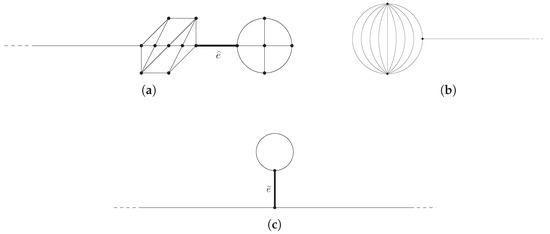 Figure 7. Examples of graphs from Theorem 3: (a) A graph whose compact core does not admit a cycle-covering; (b) A tadpole graph with extra connections between two vertices; (c) A signpost graph.
Figure 7. Examples of graphs from Theorem 3: (a) A graph whose compact core does not admit a cycle-covering; (b) A tadpole graph with extra connections between two vertices; (c) A signpost graph. - (2)
- the sequence can be constructed by considering a graph as in Figure 7b and letting the length of the compact core go to infinity keeping at the same time the total diameter of the compact core bounded (namely, thickening the compact core);
- (3)
- the sequences can be constructed by considering a signpost graph (see, e.g., Figure 7c) and letting the length of its cut-edge go to infinity and to zero, respectively.
The proofs of Theorems 2 and 3 are quite technical and we refer the reader to [24] for a complete presentation. They are based on a careful analysis of the behavior of the constant and on the “graph surgery” and rearrangement techniques developed by [1,11,12]. In particular, given a nonnegative function , one uses the decreasing rearrangement
and the symmetric rearrangement
where
and precisely the facts that
that
and that for every function u which possesses at least two preimages at each level,
to construct suitable minimizing sequences or suitable competitors to exploit level arguments analogous to (14) to get compactness in the limit.
2.2. Bound States
Besides the investigation of ground states, one can also study standing waves which are not necessarily minimizers of the constrained energy, namely bound/excited states. They may arise as constrained critical points of the energy functional on .
To the best of our knowledge all the known results on existence (and multiplicity), as well as on nonexistence, of general bound states strongly exploit the assumption on the subcriticality of the power nonlinearity (up to some exception that we mention below).
2.2.1. Existence Results
Existence and multiplicity results in this context have been proved by extending some well-known techniques from Critical Point Theory (see, e.g., [49,50,51]).
However, the context of metric graphs presents two additional technical issues. First, it is not possible, in general, to gain compactness restricting to symmetric (in some suitable sense) functions if one does not want to restrict the discussion to symmetric graphs. Furthermore, the fact that graphs with non-empty compact core are not homothetically invariant entails that multiple solutions of prescribed mass cannot be found by scaling arguments.
The strategy used in [20], to solve these problems is, then, the following:
- detecting the energy levels at which the Palais-Smale condition is satisfied, namely detect the values such that any sequence satisfying
- (i)
- (ii)
(with denoting the topological dual of the tangent to the manifold at ) admits a subsequence converging in ; - constructing suitable min-max levels.
In this case, one can prove that the constrained functional possesses the Palais-Smale property only at negative levels and whence the min-max levels must be negative. In addition, as the functional is even, it is possible to construct such min-max levels using the Krasnosel’skii genus (see, e.g., [52]), that is, for every closed and symmetric, the natural number defined by
In fact, one can prove that the suitable levels are
where
In this way it is possible to prove the following
Theorem 4
([20] [Theorem 1.2]). Let satisfy (H1)–(H3) and let . For every , there exists such that for every there exist at least k distinct pairs of bound states of mass μ. Moreover, for every ,
where denote the unique positive minimizer of constrained on and (exponentially fast) as . Finally, for each j, the Lagrange multiplier relative to is negative.
The strategy hinted before cannot be easily adapted to the extended problem since in this case the Palais-Smale condition fails also at infinitely many negative energy levels and then it is open how to fix a min-max level in the gap between two of these levels.
On the other hand, it is also unclear how to extend this strategy to the critical case. Indeed, the construction of negative energy min-max levels is based on the possibility of putting (on increasing the mass) several suitable truncations of scaled copies of on the compact core of the graph keeping the total energy negative. However, no direct analogous of such a technique is available for the critical case as the minimizers do exist only at the critical mass and present a zero energy level.
2.2.2. Nonexistence Results
Nonexistence results concern clearly only the regime since for the existence of bound states is guaranteed by Theorem 1.
The interesting part of nonexistence results for bound states in the subcritical regime is that they strongly rely both on metric and on topological features of the graph as one can see by the following
Theorem 5
([21] [Theorems 3.2 and 3.5]). Let satisfy (H1)–(H3) and let . Therefore,
- (i)
- if the graph satisfiesthen, there are no bound states of mass μ with ;
- (ii)
- if is a tree (i.e., no loops) with at most one pendant (see, e.g., Figure 8), then there is no bound state of mass μ with , for every .
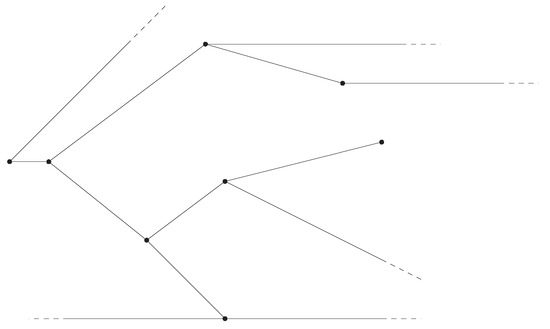 Figure 8. A tree with one pendant.
Figure 8. A tree with one pendant.
The most remarkable fact is that the dependence on metric or topological features in the nonexistence result is connected to the sign of the Lagrange multiplier. In particular, the first condition prevents the existence of bound states supported on the whole , as such functions cannot possess a negative Lagrange multiplier since they are in . On the other hand, one can check that the second part of Theorem 5 holds as well for and even in the extended nonlinearity case.
Finally, it is worth observing that the condition of the second part of Theorem 5 is sharp. Indeed, one can easily construct counterexamples whenever the assumption of being a tree with at most one pendant is dropped. Precisely, if possesses a loop, then one can define a bound state with a nonnegative Lagrange multiplier supported only on the loop (see, e.g., Figure 9a); if is a tree with two pendants, instead, then one can define a bound state with nonnegative Lagrange multiplier supported on the path which joins the two pendants (see, e.g., Figure 9b).

Figure 9.
Examples of graphs for which item (ii) of Theorem 5 does not hold: (a) A graph with a loop. (b) A tree with two pendants.
3. Nonlinear Dirac Equation
As already mentioned in Section 1, the study of bound state-solutions of NLDE (7) in the context of metric graphs has been introduced in [47]. To our knowledge, the first rigorous work on this subject for general graphs has been done in [39] for the case of localized nonlinearities.
Such discussion requires a suitable definition of the Dirac operator on graphs and the adaptation of some techniques from Critical Point Theory.
Before going more into details, we recall that Dirac-type equations are of spinorial nature and, hence, here we de deal with vector-valued function on graphs (2-spinors). More precisely, we consider wave functions that can be seen as a family of 2-spinors on intervals, i.e., with
or equivalently as 2-components vector of functions on graphs, i.e., , with and . Accordingly,
and
endowed with the natural norms, which we denote, with a little abuse of notation, by and (in the case ), respectively.
3.1. Remarks on the Dirac Operator on Graphs
As we mentioned before, the first step in the study of the NLDE on graphs is to define a self-adjoint realization of the Dirac operator.
A complete discussion of such a topic can be found, e.g., in [53,54]. Here, however, we limit ourselves to the extension that we call of Kirchhoff type, since it represents the analogous to the Schrödinger operator with Kirchhoff conditions and, hence, corresponds to the free case, that is, the case where there is no interaction at vertices (for detail on such extension, refer to [39]).
For every fixed , we define the Dirac operator of Kirchhoff type as the operator
with action
being the Pauli matrices defined in (6), and whose domain is
where
standing for or according to whether is equal to 0 or at .
Such operator can be proved to be self-adjoint and, in addition, possesses spectral properties analogous to the standard Dirac operator on , that is
even though, according to the structure of the graph, there might be eigenvalues embedded at any point of the spectrum.
The actual reason for which we call such operator of Kirchhoff type is better explained by Section 4. However, an informal justification is provided by the following formal computation. First, one can see that acts as (if ). In addition, if one considers spinors of the type and assumes that they belong to the domain of , namely that and that , one clearly sees that .
Finally, compared to the Schrödinger case, a big difference is given by the definition of the quadratic form associated with . In particular, here it is not explicitly known since Fourier transform is not available (in a simple way), as we are not in an Euclidean space, and since classical duality arguments fail, as it is not true in general that is the topological dual of .
It can be defined, clearly, using the Spectral Theorem, so that
where denotes the spectral measure associated with and ψ. However, such a definition is not useful for computations. A more precise description of the quadratic form and its domain can be obtained arguing as follows (for more details, see [39]).
First, using Real Interpolation Theory, one can prove that
whence
On the other hand, according to (24) one can decompose the form domain as the orthogonal sum of the positive and negative spectral subspaces for the operator , i.e.,
As a consequence, if one denotes and and recalls that it is possible to define a norm for as
(with given by Borel functional calculus for ), then there results that
3.2. Bound States
The study of bound states of (7) presents some relevant differences with respect to the NLS case (5) (a difference which also arises in the extended case).
The main point here is the unboundedness from below of the spectrum of which makes the associated quadratic form strongly indefinite, even fixing the -norm. Consequently, the natural energy functional associated with (7), i.e.,
is unbounded from below even under the mass constraint . Hence, no minimization can be performed and the search for constrained critical points presents several technical difficulties.
Therefore, the most promising strategy seems to be that of considering the action functional associated with (7) without any constraint. Then, for a fixed , one looks for critical points of the functional
on the form domain .
To this aim, one needs to adapt to the metric graphs setting some well-known techniques of Critical Point Theory. In particular, a suitable version of the so-called linking technique for even functional is exploited. We refer the reader to [51,55], for a general presentation of those methods in an abstract setting, together with several applications, and to [56] which deals with NLDEs.
Critical levels for are defined as the following min-max levels
with
where is the usual pseudo-gradient flow associated with , is the sphere of radius r of and γ denotes again the Krasnosel’skii genus. Indeed, one can check that if , then there exists a Palais-Smale sequence at level , i.e.,
and in addition, there results
for fixed .
As a consequence, in order to prove that , it suffices to show that the functional possesses a so-called linking geometry; namely that for every there exist and an N-dimensional space such that
where
and
and that there exist such that
(for a graphic intuition see, e.g., Figure 10).
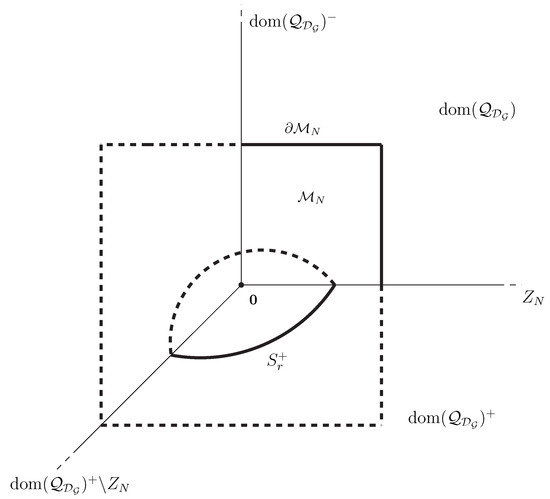
Figure 10.
A graphic insight on linking geometry.
Finally, checking the validity of the Palais-Smale condition at positive levels for the action functional it is possible to prove the following
Theorem 6
([39] [Theorem 2.11]). Let satisfy (H1)–(H3) , and . Then, for every there exists infinitely many (distinct) pairs of bound states of frequency ω of the NLDE, at mass m and relativistic parameter c.
4. Nonrelativistic Limit
The NLDE and the NLSE equation are clearly closely related as, physically, the latter should correspond to the nonrelativistic limit of the former. Heuristically, one expects to recover the NLSE from NLDE as the relativistic parameter tends to infinity (namely, “”), that is, neglecting relativistic effects. It is, then, particularly interesting to rigorously establish such a connection.
This has been first done in [57] for the Dirac-Fock equations proving the convergence of bound states to those of the (nonrelativistic) Hartree-Fock model.
More in detail, given a sequence , one is interested in the limit behavior of a sequence of bound states with frequencies . Precisely, one must choose frequencies such that
This represents a kind of renormalization, which corresponds to the fact that one must subtract the rest energy of the particles, as this property is a peculiarity of relativistic theories which is absent in the nonrelativistic setting.
The strategy adopted in [39] is an adaptation of the one developed in [57]. Namely, first one has to establish uniform bounds for the sequence of the bound states and then, suitably manipulating (7), one has to prove that the lower component goes to zero while the sequence of upper components is a Palais-Smale sequence for the action functional associated with (5), namely for
at a fixed . Therefore, up to a compactness argument, the existence of a limit satisfying the NLSE is proved.
However, we would like to remark that some relevant differences are present here with respect to [57] that call for some relevant modifications of the proofs. In particular, in [57] bound states were obtained as constrained critical points of the energy. Consequently, the uniform boundedness of the -norms and the non-triviality of the limit are easily obtained. On the contrary, in the case considered in [39], those properties are not a priori guaranteed and represent two main points of the proofs.
However, for the sake of completeness, we mention that in [57] one of the most delicate parts the proof is to estimate the sequence of the Lagrange multipliers corresponding to the -constraint, proving that they are in the spectral gap of the operator. This, actually, is one of the reasons for which in [39] we looked for critical points of the action and not for the constrained critical points of the energy, to avoid such additional technical difficulties.
In view of all the above remarks it is possible to state the following
Theorem 7
([39] [Theorem 2.12]). Let satisfy (H1)–(H3) , , and . Let also be two real sequences such that
If is a sequence of bound states of frequency of the NLDE at relativistic parameter , then, up to subsequences, there holds
where u is a bound state of frequency λ of the NLSE.
Actually, the bound states of NLDE do not converge exactly to the bound states of the NLSE depicted in (7). In fact, u is a solution of
The coefficient is consistent with the fact that in the nonrelativistic limit the kinetic (free) part of the Hamiltonian of a particle is given by
Remark 3.
It is also worth observing that Theorem 7, in contrast to Theorem 6, holds only for a fixed range of exponents, the -subcritical case: .
5. Conclusion: A Brief Summary
In this final section we provide in Table 1 a summary of the results presented in the review. However, before showing it, some remarks are in order:

Table 1.
Summarizing Table.
- (i)
- the mentioned results only concerne the “free” self-adjoint extensions of the Laplacian and the Dirac operator introduced in Section 1 and Section 3.1, respectively;
- (ii)
- in order to find bound states, in the NLS case one fixes the mass μ and studies constrained critical points of the energy functional (thus providing no information on the frequencies λ that arise naturally as Lagrange multipliers), while in the NLD case one fixes the frequency ω and discusses the connected action functional (thus losing any information on the mass of the resulting critical points);
- (iii)
- the nonrelativistic limit must be considered (as above) a limit for a sequence of relativistic parameters and a suitably “tuned” sequence of frequencies ;
- (iv)
- since (clearly) a ground state is a bound state too, the fourth column of the Table 1 must be meant to refer to those bound states which are not ground states;
- (v)
- the constants are defined by: (with introduced in Theorem 1–item (i)) and (with introduced in (10)–(11));
- (vi)
Author Contributions
All authors contributed equally to this work.
Funding
This research was partially funded by INdAM—GNAMPA Project 2018: “Variational Problems and Applications”.
Conflicts of Interest
The authors declare no conflict of interest.
References
- Adami, R.; Serra, E.; Tilli, P. NLS ground states on graphs. Calc. Var. Part. Differ. Equ. 2015, 54, 743–761. [Google Scholar] [CrossRef]
- Berkolaiko, G.; Kuchment, P. Introduction to Quantum Graphs; Mathematical Surveys and Monographs, 186; American Mathematical Society: Providence, RI, USA, 2013; ISBN 978-0-8218-9211-4. [Google Scholar]
- Adami, R.; Serra, E.; Tilli, P. Nonlinear dynamics on branched structures and networks. Riv. Math. Univ. Parma (N.S.) 2017, 8, 109–159. [Google Scholar]
- Gnutzmann, S.; Waltner, D. Stationary waves on nonlinear quantum graphs: General framework and canonical perturbation theory. Phys. Rev. E 2016, 93, 032204. [Google Scholar] [CrossRef] [PubMed]
- Noja, D. Nonlinear Schrödinger equation on graphs: Recent results and open problems. Philos. Trans. R. Soc. Lond. Ser. A Math. Phys. Eng. Sci. 2014, 372, 20130002. [Google Scholar] [CrossRef]
- Lorenzo, M.; Lucci, M.; Merlo, V.; Ottaviani, I.; Salvato, M.; Cirillo, M.; Müller, F.; Weimann, T.; Castellano, M.G.; Chiarello, F.; et al. On Bose-Einstein condensation in Josephson junctions star graph arrays. Phys. Lett. A 2014, 378, 655–658. [Google Scholar] [CrossRef]
- Adami, R.; Cacciapuoti, C.; Finco, D.; Noja, D. Fast solitons on star graphs. Rev. Math. Phys. 2011, 23, 409–451. [Google Scholar] [CrossRef]
- Adami, R.; Cacciapuoti, C.; Finco, D.; Noja, D. On the structure of critical energy levels for the cubic focusing NLS on star graphs. J. Phys. A 2012, 45, 3738–3777. [Google Scholar] [CrossRef]
- Adami, R.; Cacciapuoti, C.; Finco, D.; Noja, D. Variational properties and orbital stability of standing waves for NLS equation on a star graph. J. Differ. Equ. 2014, 257, 3738–3777. [Google Scholar] [CrossRef]
- Adami, R.; Cacciapuoti, C.; Finco, D.; Noja, D. Constrained energy minimization and orbital stability for the NLS equation on a star graph. Ann. Inst. H Poincaré Anal. Non Linéaire 2014, 31, 1289–1310. [Google Scholar] [CrossRef]
- Adami, R.; Serra, E.; Tilli, P. Threshold phenomena and existence results for NLS ground states on metric graphs. J. Funct. Anal. 2016, 271, 201–223. [Google Scholar] [CrossRef]
- Adami, R.; Serra, E.; Tilli, P. Negative energy ground states for the L2-critical NLSE on metric graphs. Commun. Math. Phys. 2017, 352, 387–406. [Google Scholar] [CrossRef]
- Adami, R.; Serra, E.; Tilli, P. Multiple positive bound states for the subcritical NLS equation on metric graphs. Calc. Var. Part. Diff. Equ. 2019, 58. [Google Scholar] [CrossRef]
- Cacciapuoti, C.; Finco, D.; Noja, D. Topology-induced bifurcations for the nonlinear Schrödinger equation on the tadpole graph. Phys. Rev. E 2015, 91, 013206. [Google Scholar] [CrossRef] [PubMed]
- Kairzhan, A.; Pelinovsky, D.E. Nonlinear instability of half-solitons on star graphs. J. Differ. Equ. 2018, 264, 7357–7383. [Google Scholar] [CrossRef]
- Noja, D.; Pelinovsky, D.; Shaikhova, G. Bifurcations and stability of standing waves in the nonlinear Schrödinger equation on the tadpole graph. Nonlinearity 2015, 28, 2343–2378. [Google Scholar] [CrossRef]
- Noja, D.; Rolando, S.; Secchi, S. Standing waves for the NLS on the double-bridge graph and a rational-irrational dichotomy. J. Differ. Equ. 2019, 266, 147–178. [Google Scholar] [CrossRef]
- Cacciapuoti, C.; Finco, D.; Noja, D. Ground state and orbital stability for the NLS equation on a general starlike graph with potentials. Nonlinearity 2017, 30, 3271–3303. [Google Scholar] [CrossRef]
- Gnutzmann, S.; Smilansky, U.; Derevyanko, S. Stationary scattering from a nonlinear network. Phys. Rev. A 2011, 83, 033831. [Google Scholar] [CrossRef]
- Serra, E.; Tentarelli, L. Bound states of the NLS equation on metric graphs with localized nonlinearities. J. Differ. Equ. 2016, 260, 5627–5644. [Google Scholar] [CrossRef]
- Serra, E.; Tentarelli, L. On the lack of bound states for certain NLS equations on metric graphs. Nonlinear Anal. 2016, 145, 68–82. [Google Scholar] [CrossRef]
- Tentarelli, L. NLS ground states on metric graphs with localized nonlinearities. J. Math. Anal. Appl. 2016, 433, 291–304. [Google Scholar] [CrossRef]
- Dovetta, S.; Tentarelli, L. Ground states of the L2-critical NLS equation with localized nonlinearity on a tadpole graph. arXiv, 2018; arXiv:1803.09246. [Google Scholar]
- Dovetta, S.; Tentarelli, L. L2-critical NLS on noncompact metric graphs with localized nonlinearity: Topological and metric features. arXiv, 2018; arXiv:1811.02387. [Google Scholar]
- Cacciapuoti, C.; Dovetta, S.; Serra, E. Variational and stability properties of constant solutions to the NLS equation on compact metric graphs. Milan J. Math. 2018, 86, 305–327. [Google Scholar] [CrossRef]
- Dovetta, S. Existence of infinitely many stationary solutions of the L2-subcritical and critical NLSE on compact metric graphs. J. Differ. Equ. 2018, 264, 4806–4821. [Google Scholar] [CrossRef]
- Duca, A. Global exact controllability of the bilinear Schrödinger potential type models on quantum graphs. arXiv, 2017; arXiv:1710.06022. [Google Scholar]
- Marzuola, J.L.; Pelinovsky, D.E. Ground state on the dumbbell graph. Appl. Math. Res. Express AMRX 2016, 98–145. [Google Scholar] [CrossRef]
- Adami, R.; Dovetta, S.; Serra, E.; Tilli, P. Dimensional crossover with a continuum of critical exponents for NLS on doubly periodic metric graphs. arXiv, 2018; arXiv:1805.02521. [Google Scholar]
- Dovetta, S. Mass-constrained ground states of the stationary NLSE on periodic metric graphs. arXiv, 2018; arXiv:1811.06798. [Google Scholar]
- Gilg, S.; Pelinovsky, D.E.; Schneider, G. Validity of the NLS approximation for periodic quantum graphs. NoDEA Nonlinear Differ. Equ. Appl. 2016, 23, 63. [Google Scholar] [CrossRef]
- Pelinovsky, D.E.; Schneider, G. Bifurcations of standing localized waves on periodic graphs. Ann. Henri Poincaré 2017, 18, 1185–1211. [Google Scholar] [CrossRef]
- Mugnolo, D.; Noja, D.; Seifert, C. Airy-type evolution equations on star graphs. Anal. PDE 2018, 11, 1625–1652. [Google Scholar] [CrossRef]
- Musslimani, Z.H.; Makris, K.G.; El-Ganainy, R.; Christodoulides, D.N. Optical solitons in PT periodic potentials. Phys. Rev. Lett. 2008, 100, 030402. [Google Scholar] [CrossRef] [PubMed]
- Ablowitz, M.J.; Musslimani, Z.H. Integrable nonlocal nonlinear Schrödinger equation. Phys. Rev. Lett. 2013, 110, 064105. [Google Scholar] [CrossRef] [PubMed]
- Ablowitz, M.J.; Musslimani, Z.H. Integrable nonlocal nonlinear equation. Stud. Appl. Math. 2017, 139, 7–59. [Google Scholar] [CrossRef]
- Kurasov, P.; Majidzadeh Garjani, B. Quantum graphs: PT -symmetry and reflection symmetry of the spectrum. J. Math. Phys. 2017, 58, 023506. [Google Scholar] [CrossRef]
- Matrasulov, D.U.; Sabirov, K.K.; Yusupov, J.R. PT-symmetric quantum graphs. arXiv, 2018; arXiv:1805.08104. [Google Scholar]
- Borrelli, W.; Carlone, R.; Tentarelli, L. Nonlinear Dirac equation on graphs with localized nonlinearities: Bound states and nonrelativistic limit. arXiv, 2018; arXiv:1807.06937. [Google Scholar]
- Haddad, L.H.; Carr, L.D. The nonlinear Dirac equation in Bose-Einstein condensates: Foundation and symmetries. Physical D 2009, 238, 1413–1421. [Google Scholar] [CrossRef]
- Tran, T.X.; Longhi, S.; Biancalana, F. Optical analogue of relativistic Dirac solitons in binary waveguide arrays. Ann. Phys. 2014, 340, 179–187. [Google Scholar] [CrossRef]
- Arbunich, J.; Sparber, C. Rigorous derivation of nonlinear Dirac equations for wave propagation in honeycomb structures. J. Math. Phys. 2018, 59, 011509. [Google Scholar] [CrossRef]
- Borrelli, W. Stationary solutions for the 2D critical Dirac equation with Kerr nonlinearity. J. Differ. Equ. 2017, 263, 7941–7964. [Google Scholar] [CrossRef]
- Borrelli, W. Multiple solutions for a self-consistent Dirac equation in two dimensions. J. Math. Phys. 2018, 59, 041503. [Google Scholar] [CrossRef]
- Borrelli, W. Weakly localized states for nonlinear Dirac equations. Calc. Var. Part. Differ. Equ. 2018, 57, 155. [Google Scholar] [CrossRef]
- Fefferman, C.L.; Weinstein, M.I. Wave Packets in Honeycomb Structures and Two-Dimensional Dirac Equations. Commun. Math. Phys. 2014, 326, 251–286. [Google Scholar] [CrossRef]
- Sabirov, K.K.; Babajanov, D.B.; Matrasulov, D.U.; Kevrekidis, P.G. Dynamics of Dirac solitons in networks. J. Phys. A 2018, 51, 435203. [Google Scholar] [CrossRef]
- Cazenave, T. Semilinear Schrödinger Equations; Courant Lecture Notes in Mathematics, 10; American Mathematical Society: Providence, RI, USA, 2003; ISBN 0-8218-3399-5. [Google Scholar]
- Ambrosetti, A.; Malchiodi, A. Nonlinear Analysis and Semilinear Elliptic Problems; Cambridge Studies in Advanced Mathematics, 104; Cambridge University Press: Cambridge, UK, 2007; ISBN 978-0-521-86320-9. [Google Scholar]
- Berestycki, H.; Lions, P.-L. Nonlinear scalar field equations II. Existence of infinitely many solutions. Arch. Rational. Mech. Anal. 1983, 82, 347–375. [Google Scholar] [CrossRef]
- Rabinowitz, P.H. Minimax Methods in Critical Point Theory With Applications to Differential Equations; CBMS Regional Conference Series in Mathematics, 65; American Mathematical Society: Providence, RI, USA, 1986. [Google Scholar]
- Krasnosel’skii, M.A. Topological Methods in the Theory of Nonlinear Integral Equations; A Pergamon Press Book; The Macmillan Co.: New York, NY, USA, 1964. [Google Scholar]
- Bulla, W.; Trenkler, T. The free Dirac operator on compact and noncompact graphs. J. Math. Phys. 1990, 31, 1157–1163. [Google Scholar] [CrossRef]
- Post, O. Equilateral quantum graphs and boundary triples. In Analysis on Graphs and Its Applications; Proc. Sympos. Pure Math., 77; American Mathematical Society: Providence, RI, USA, 2008; pp. 469–490. [Google Scholar]
- Struwe, M. Variational Methods. Applications to Nonlinear Partial Differential Equations and Hamiltonian Systems, 4th ed.; Results in Mathematics and Related Areas, 3rd Series; A Series of Modern Surveys in Mathematics, 34; Springer: Berlin, Germany, 2008; ISBN 978-3-540-74012-4. [Google Scholar]
- Esteban, M.J.; Séré, E. Stationary states of the nonlinear Dirac equation: A variational approach. Commun. Math. Phys. 1995, 171, 323–350. [Google Scholar] [CrossRef]
- Esteban, M.J.; Séré, E. Nonrelativistic limit of the Dirac-Fock equations. Ann. Henri Poincaré 2001, 2, 941–961. [Google Scholar] [CrossRef]
© 2019 by the authors. Licensee MDPI, Basel, Switzerland. This article is an open access article distributed under the terms and conditions of the Creative Commons Attribution (CC BY) license (http://creativecommons.org/licenses/by/4.0/).